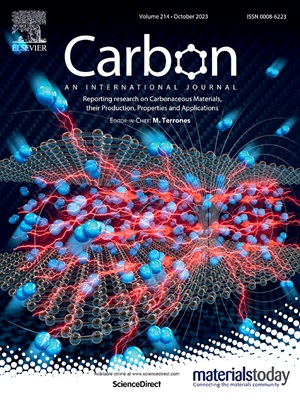富含氮的石墨化碳纤维来源于一种用于稳定高能电池的有机颜料
IF 11.6
2区 材料科学
Q1 CHEMISTRY, PHYSICAL
引用次数: 0
摘要
金属锂阳极具有高比容量和低氧化还原电位的特点,是锂离子电池的理想阳极。然而,金属锂阳极的实际应用受到枝晶形成、低库仑效率和安全风险的阻碍。为了缓解这些挑战,一个有效的策略是使用碳基集热器。本研究强调了富氮石墨化碳纤维(NGC)的潜力,该富氮石墨化碳纤维(NGC)是通过静电纺丝法制备的,可作为锂离子和锂金属电池的亲锂多孔集流剂。通过调节600 ~ 1500℃的炭化温度,可以控制纤维的氮、氧含量和碳结晶度。在锂离子电池和锂硫电池中,600℃炭化后的NGC-T600具有丰富的表面官能团(C=O和C- n),比容量最高。相反,在锂金属电池中,在1000℃下碳化的NGC-T1000在高面电流密度和更大的锂沉积容量下表现出最稳定的循环性能,具有高库仑效率。这些发现表明,碳支架中氮相关键和结晶度之间的相互作用影响了锂的储存机制、电化学可逆性和NGC的动力学,从而产生了锂离子和锂金属电池中不同的电化学行为。本文章由计算机程序翻译,如有差异,请以英文原文为准。

Nitrogen-enriched, graphitizable carbon fibers derived from an organic pigment for stable high-energy batteries
Metallic lithium (Li) anodes are ideal for Li-ion batteries owing to the high specific capacity and low redox potential of Li. However, the practical applications of metallic Li anodes are hindered by dendrite formation, low Coulombic efficiencies, and safety risks. In order to mitigate these challenges, one effective strategy is to use carbon-based current collectors. This study highlights the potential of nitrogen-enriched, graphitizable carbon fibers Nitrogen-enriched, graphitizable carbon fibers (NGC), prepared by electrospinning a C.I. Pigment Red 122 solution, as lithiophilic and porous current collectors for Li-ion and Li-metal batteries. The nitrogen and oxygen contents and carbon crystallinity of the fibers are controlled by adjusting carbonization temperatures from 600 to 1500 °C. In both Li-ion and Li-sulfur batteries, NGC-T600, carbonized at 600 °C, achieves the highest specific capacity owing to abundant surface-functional groups (C=O and C–N). Conversely, in Li-metal batteries, NGC-T1000, carbonized at 1000 °C, demonstrates the most stable cycling performance with a high Coulombic efficiency under high areal current densities and larger Li deposition capacities. These findings suggest that the interplay between nitrogen-associated bonds and degree of crystallinity in carbon scaffolds influences the Li storage mechanisms, electrochemical reversibility, and kinetics of the NGC, yielding different electrochemical behaviors in Li-ion and Li-metal batteries.
求助全文
通过发布文献求助,成功后即可免费获取论文全文。
去求助
来源期刊

Carbon
工程技术-材料科学:综合
CiteScore
20.80
自引率
7.30%
发文量
0
审稿时长
23 days
期刊介绍:
The journal Carbon is an international multidisciplinary forum for communicating scientific advances in the field of carbon materials. It reports new findings related to the formation, structure, properties, behaviors, and technological applications of carbons. Carbons are a broad class of ordered or disordered solid phases composed primarily of elemental carbon, including but not limited to carbon black, carbon fibers and filaments, carbon nanotubes, diamond and diamond-like carbon, fullerenes, glassy carbon, graphite, graphene, graphene-oxide, porous carbons, pyrolytic carbon, and other sp2 and non-sp2 hybridized carbon systems. Carbon is the companion title to the open access journal Carbon Trends. Relevant application areas for carbon materials include biology and medicine, catalysis, electronic, optoelectronic, spintronic, high-frequency, and photonic devices, energy storage and conversion systems, environmental applications and water treatment, smart materials and systems, and structural and thermal applications.
 求助内容:
求助内容: 应助结果提醒方式:
应助结果提醒方式:


